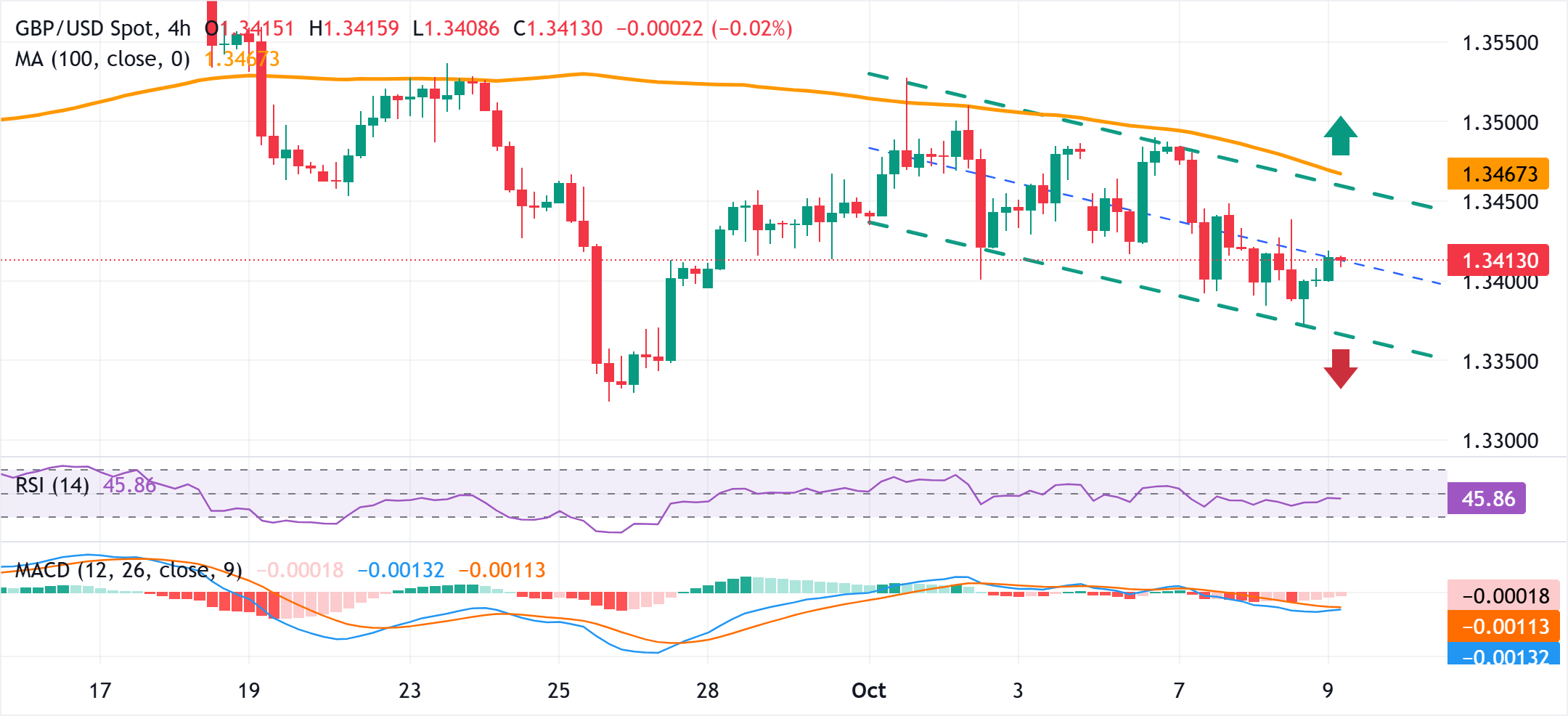Created
: 2025.10.09














![]() 2025.10.09 13:57
2025.10.09 13:57
The GBP/USD pair attracts some buyers during the Asian session on Thursday and moves away from a nearly two-week trough, around the 1.3370 area touched the previous day. Spot prices climb further beyond the 1.3400 mark in the last hour and, for now, seem to have snapped a two-day losing streak amid a broadly weaker US Dollar (USD).
From a technical perspective, the recent repeated failures near the 100-period Simple Moving Average (SMA) and the downfall along a descending channel since the beginning of this month favor the GBP/USD bears. Furthermore, negative oscillators on 4-hour/daily charts suggest that any subsequent move up might still be seen as a selling opportunity and run the risk of fizzling out rather quickly.
Hence, it will be prudent to wait for a sustained strength above the 1.3465-1.3475 confluence hurdle - comprising the top end of the descending channel and the 100-period SMA - before positioning for further gains. Some follow-through buying beyond the 1.3500 psychological mark could lift the GBP/USD pair above the 1.3525-1.3530 supply zone, towards the next relevant barrier near the 1.3575-1.3580 area.
On the flip side, the 1.3370 area, representing the lower boundary of the downward sloping channel, might continue to protect the immediate downside, below which the GBP/USD pair could retest the 1.3330-1.3325 zone, or a nearly two-month low touched in September. The subsequent fall below the 1.3300 round figure will be seen as a fresh trigger for bearish traders and pave the way for deeper losses.

The Pound Sterling (GBP) is the oldest currency in the world (886 AD) and the official currency of the United Kingdom. It is the fourth most traded unit for foreign exchange (FX) in the world, accounting for 12% of all transactions, averaging $630 billion a day, according to 2022 data. Its key trading pairs are GBP/USD, also known as 'Cable', which accounts for 11% of FX, GBP/JPY, or the 'Dragon' as it is known by traders (3%), and EUR/GBP (2%). The Pound Sterling is issued by the Bank of England (BoE).
The single most important factor influencing the value of the Pound Sterling is monetary policy decided by the Bank of England. The BoE bases its decisions on whether it has achieved its primary goal of "price stability" - a steady inflation rate of around 2%. Its primary tool for achieving this is the adjustment of interest rates. When inflation is too high, the BoE will try to rein it in by raising interest rates, making it more expensive for people and businesses to access credit. This is generally positive for GBP, as higher interest rates make the UK a more attractive place for global investors to park their money. When inflation falls too low it is a sign economic growth is slowing. In this scenario, the BoE will consider lowering interest rates to cheapen credit so businesses will borrow more to invest in growth-generating projects.
Data releases gauge the health of the economy and can impact the value of the Pound Sterling. Indicators such as GDP, Manufacturing and Services PMIs, and employment can all influence the direction of the GBP. A strong economy is good for Sterling. Not only does it attract more foreign investment but it may encourage the BoE to put up interest rates, which will directly strengthen GBP. Otherwise, if economic data is weak, the Pound Sterling is likely to fall.
Another significant data release for the Pound Sterling is the Trade Balance. This indicator measures the difference between what a country earns from its exports and what it spends on imports over a given period. If a country produces highly sought-after exports, its currency will benefit purely from the extra demand created from foreign buyers seeking to purchase these goods. Therefore, a positive net Trade Balance strengthens a currency and vice versa for a negative balance.
![]()
Created
: 2025.10.09
![]()
Last updated
: 2025.10.09

FXStreet is a forex information website, delivering market analysis and news articles 24/7.
It features a number of articles contributed by well-known analysts, in addition to the ones by its editorial team.
Founded in 2000 by Francesc Riverola, a Spanish economist, it has grown to become a world-renowned information website.
We hope you find this article useful. Any comments or suggestions will be greatly appreciated.
We are also looking for writers with extensive experience in forex and crypto to join us.
please contact us at [email protected].
Disclaimer:
All information and content provided on this website is provided for informational purposes only and is not intended to solicit any investment. Although all efforts are made in order to ensure that the information is correct, no guarantee is provided for the accuracy of any content on this website. Any decision made shall be the responsibility of the investor and Myforex does not take any responsibility whatsoever regarding the use of any information provided herein.
The content provided on this website belongs to Myforex and, where stated, the relevant licensors. All rights are reserved by Myforex and the relevant licensors, and no content of this website, whether in full or in part, shall be copied or displayed elsewhere without the explicit written permission of the relevant copyright holder. If you wish to use any part of the content provided on this website, please ensure that you contact Myforex.
Myforex uses cookies to improve the convenience and functionality of this website. This website may include cookies not only by us but also by third parties (advertisers, log analysts, etc.) for the purpose of tracking the activities of users. Cookie policy